Selective Brush Plating a Tin-Zinc Alloy for Sacrificial Corrosion Protection
A tin-zinc selective brush plated coating has been developed to provide sacrificial corrosion protection without the use of toxic chemicals.
By Zhimin Zhong, Sidney Clouser and Derek Vanek, Sifco Applied Surface Concepts
Editor's Note: This paper is a peer-reviewed and edited version of a presentation delivered at NASF SUR/FIN 2013 in Rosemont, Ill., on June 11, 2013. A printable PDF version is available by clicking HERE.
ABSTRACT
A tin-zinc selective brush plated coating has been developed to provide sacrificial corrosion protection without the use of toxic chemicals. The coating is 80% tin, 20% zinc by weight. Neutral salt spray tests on the brush plated coatings have shown basis metal protection up to 500 hr. with a 0.5 mil coating. When combined with the appropriate conversion coating, trivalent or chromium-free, the formation of white zincate corrosion products is prevented for 96 hr. of salt spray. When the deposition is carried out at >50°C tests with Type 2a hydrogen embrittlement (HE) rings and Type 1a.1 notched bars meet the ASTM 519 requirement without a post-plating HE relief bake. Plating at lower electrolyte temperature requires an HE relief bake after plating. The research work identified a neutral nickel coating that can be applied prior to the tin-zinc coating plated at room temperature which eliminates the need for a post plating HE relief bake for high strength steel.
Keywords: selective plating, tin-zinc alloys, hydrogen embrittlement, ASTM 519, sacrificial corrosion protection
Introduction
Sacrificial coatings are applied to surfaces both by bath and by selective brush plating to protect the underlying substrate from corrosion. The sacrificial coating corrodes in preference to the substrate, a property which is especially important when the substrate is scratched or damaged. Cadmium has long been used to provide this protection for structures, equipment and fasteners. It is easy to plate and it has desirable properties that include corrosion protection, lubricity, anti-galling, electrical conductivity and low hydrogen embrittlement.
Due to cadmium’s toxic nature, there is a tremendous amount of pressure to stop its use. Environmental concerns and regulatory mandates are driving manufacturers to find alternatives for cadmium. Therefore, identifying a suitable, non-embrittling cadmium replacement is of great interest. Tin-zinc and other zinc alloys are finding use in several industries for this purpose.
Tin-zinc alloys
Tin-zinc alloys offer excellent sacrificial corrosion protection for steel by combining the barrier protection of tin and the galvanic protection of zinc without the bulky corrosion product associated with a simple zinc coating.1-16 In addition to corrosion protection, the tin-zinc alloy provides good lubricity, wear resistance and excellent solderability. Sifco Applied Surface Concepts has developed a new, non-embrittling, tin-zinc brush plating process. The sacrificial coating can be selectively applied to variety of surfaces including high strength steels in aircraft landing gear (Fig. 1).
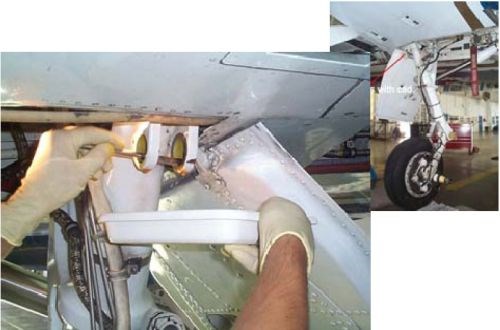
Figure 1 - Conversion coating being applied to a sacrificial coating brush plated onto a main landing gear bushing.
A review of tin-zinc electroplating solutions
As a precursor to the development of a new tin-zinc brush plating solution, we reviewed and evaluated the performance of both alkaline and neutral tin-zinc baths. Although the hardness and corrosion resistance of the alkaline bath were acceptable, the elevated solution temperature required for the deposition of tin-zinc was highly detrimental to the anode cover material that is a requirement for brush plating. But most importantly, the plated deposit did not pass hydrogen embrittlement testing.
Tin-zinc electrolyte for brush plating
We have developed a proprietary neutral, sulfate-gluconate tin-zinc solution** that provides a deposit of 80 wt% tin and 20 wt% zinc, and contains no toxic chemicals. The various electrolytes and plating conditions investigated in this study are shown in Table 1.
The XRD pattern shows the 0.5 mil deposit on steel panel as a simple mixture of tetragonal tin (JCPDS 4-673) and hexagonal close-packed zinc (JCPDS 87-713) (Fig. 2). No other phase is detected. This is consistent with the phase diagram of Sn-Zn binary system (Fig. 3). The phase diagram shows that tin and zinc do not form any metallic compound. The solubility of zinc in β tin (i.e., tetragonal tin) is less than 1.0 at% and the solubility of tin in zinc is even lower (~0.04 at%). The phase diagram also indicates the low melting temperature of 198.5°C for a eutectic composition of 14.9 at% of zinc and 85.1 at% of tin.
Table 1 - Comparison of tin-zinc electrolytes for brush plating.
| Alkaline | Neutral-based | Proprietary | |
|---|---|---|---|
| Solution pH | >13.0 | 6.0-7.0 | 6.0-7.0 |
| Metals (g/L) | 88-100 | 35 | 32-36 |
| Active metal ions | Sn+4, Zn+2 | Sn+2, Zn+2 | Sn+4, Zn+2 |
| Cathode current density, A/in2 | 0.5-2.0 | 0.5-1.5 | 0.5-1.5 |
| Plating temperature, ºC | 60-70 | 18-22 | 20-60 |
| Cathode current efficiency, % | 80 | 40 | 45 at 20ºC 80 at 50ºC |
| Plating rate at 1.0 A/in2, mil/min | 0.13 | 0.11 | 0.11 at 20ºC 0.22 at 50ºC |
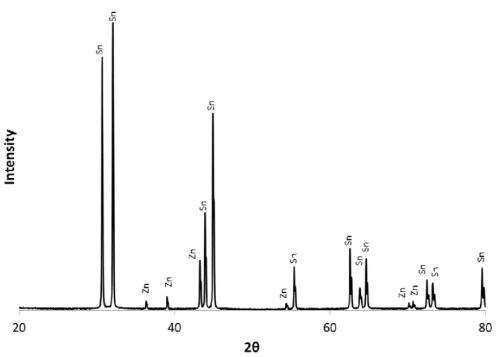
Figure 2 - XRD pattern of brush plated 80:20 Sn-Zn alloy.

Figure 3 - Sn-Zn phase diagram (Landolt-Börnstein new series IV).
The surface morphology of the 0.5 mil Sn-Zn deposits have been inspected by SEM. The deposit is relatively even and fine grained as can be seen in Fig. 4. The color of the deposit is light gray, similar to the color of brush plated tin.
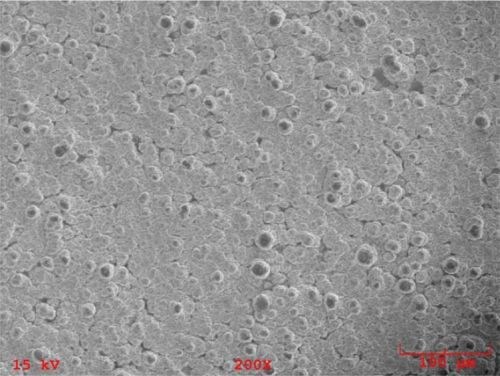
Figure 4 - Scanning electron micrograph of a 0.5 mil Sn-Zn deposit.
Hydrogen embrittlement (HE) tests with type 2a rings and type 1a.1 notched bars have shown that when tin-zinc is deposited at >50°C, the requirements of ASTM 519 are met without a post plating relief bake. Plating at a lower temperature does, however, require a post plating relief bake. Further, our research identified a neutral nickel deposit that can be applied prior to the tin-zinc deposit plated at room temperature, eliminating the need for a post plating HE relief bake for high strength steel. Both Type 2a rings and Type 1a.1 notched bars brush plated at room temperature with tin-zinc pass the HE test if the neutral nickel pre-plate is applied.
It is generally accepted that it is the absorption of the hydrogen atom that causes hydrogen embrittlement.17-19 At high plating temperatures, hydrogen atoms form stable hydrogen molecules at a high rate that alleviates the problem of hydrogen absorption. High temperature also improves plating efficiency, generating less hydrogen. Therefore, plating at an elevated temperature reduces the problem of hydrogen embrittlement.
The absorption of the hydrogen atom by the steel substrate can also be impeded by a nickel barrier layer.20-21 When hydrogen atoms are generated during a plating process, they can be absorbed by the steel substrate to cause hydrogen embrittlement. As the diffusion coefficient of hydrogen in nickel is low, the amount of hydrogen that can be absorbed is reduced due to the nickel barrier layer. Both plating at the elevated temperature and pre-plating with a nickel barrier layer are effective ways to prevent hydrogen embrittlement using this electrolyte. Figure 5 is a photograph of 2a rings plated with our proprietary tin-zinc process that have passed the HE test. Figure 6 is a photograph of 1a.1 notched bars also plated with the tin-zinc deposit after 200 hr of hydrogen embrittlement testing.
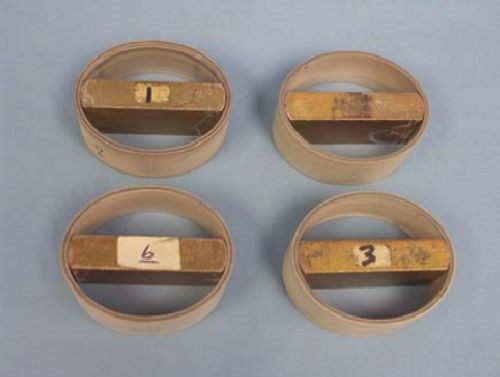
Figure 5 - Sn-Zn alloy plated 2a rings with stress bars inserted.
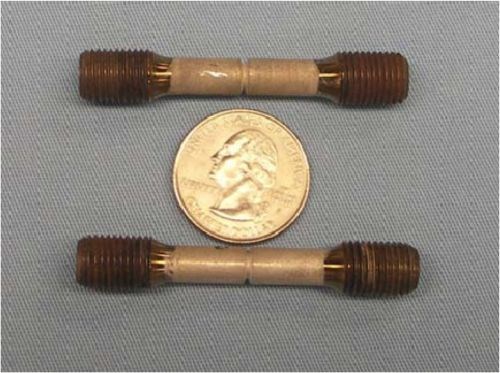
Figure 6 - Sn-Zn alloy plated 1a.1 notched bars after 200 hr of HE testing.
The plating efficiency is above 80% at a current density of 0.5 - 1.5 A/in2 when plated at >50°C. The plating efficiency is reduced to about 45% if plated at ambient temperature. Temperature does not significantly influence the composition or the hardness of the deposit.
Several samples were plated on panels and tubes to a thickness of more than 3.0 mil (75 µm). The samples were cross sectioned, mounted and polished for microhardness measurement. The load of Vickers hardness test was 10 g. The measured hardness was between 14 and 20VHN with an average close to 17VHN. There was no significant difference in hardness between the brush plated tin-zinc alloy and the tin-zinc alloy plated by commercially available processes of alkaline or neutral baths.
The tank plated tin-zinc alloy is soft, as is the brush plated tin-zinc alloy. The hardness is comparable to that of cadmium. It is anticipated that the coating has good lubricity and solderability. Figure 7 is an optical micrograph of the coating on a steel substrate. The polished surface was nital etched to reveal the microstructure of the tin-zinc alloy.
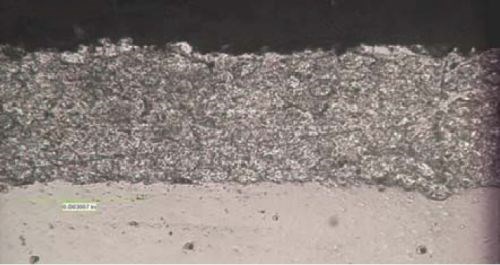
Figure 7 - Cross section of the tin-zinc alloy coating on a steel substrate.
As a replacement for cadmium brush plated tin-zinc is applied onto localized areas of new parts, or for localized touch-up on repair parts. Our tin-zinc provides two options for the application of a non-embrittling tin-zinc.
Conversion coating
The corrosion resistance of chromated (hexavalent) tin-zinc has been extensively examined and the excellent performance is well known. As with cadmium, the poisonous nature of hexavalent chromium has led to its severe restriction (even more than that of cadmium). In this investigation, the conversion coatings applied to the tin-zinc were limited to trivalent chromium and chromium-free coatings.
Without a conversion coating, the white corrosion starts to appear after 24 hr of salt spray. The white corrosion becomes extensive after 96 hr of salt spray. For a 0.5 mil thick deposit, red corrosion starts around 500 hr of salt spray. A commercially available trivalent chromium conversion coating has been tested on the brush plated tin-zinc.15-16 The tin-zinc alloy coating with this conversion treatment endured 96 hr of salt spray with minimum of white corrosion. Figure 8 is a photograph of a panel after 96 hr of salt spray. For 0.5 mil of our tin-zinc deposit, red corrosion appears between 800 and 1000 hr of salt spray.
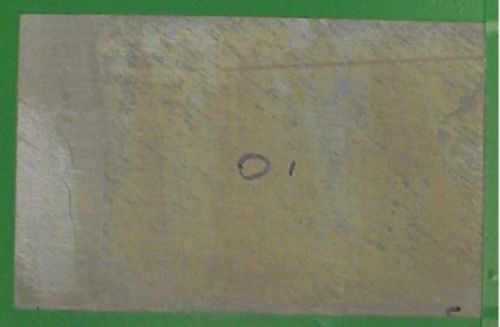
Figure 8 - Steel panel with a tin-zinc alloy coating and a trivalent chromium conversion coating after 96 hr of salt spray testing.
A chromium-free conversion coating was also tested on the tin-zinc deposit.22-23 The active ingredients for the conversion coating are zinc phosphate, fluotitanic acid, ammonium molybdate and an organic polymer. Therefore, it is free of chromium and cobalt salts (hazardous chemicals in some trivalent conversion coatings). The more environmentally friendly chromium-free conversion coating has been reported to have performance comparable to a trivalent conversion coating on a zinc deposit. There is no report on its corrosion test on a tin-zinc deposit.
The brush plated tin-zinc with the chromium-free conversion coating performed well in a salt spray test. There was little white corrosion after 96 hr of salt spray carried out following ASTM B-117. Figure 9 is a photograph of the test result. It is comparable or better than the panel with the trivalent chromium conversion treatment. For 0.5 mil of tin-zinc deposit with the conversion coating, red corrosion also appears between 800 and 1,000 hr of salt spray.
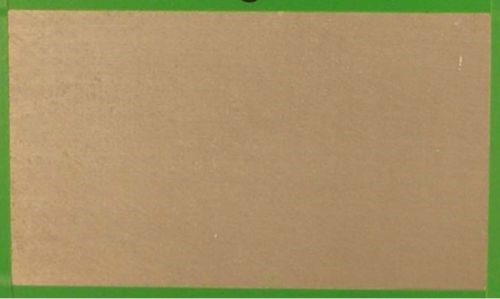
Figure 9 - Steel panel with a tin-zinc alloy coating and a chromium-free conversion coating after 96 hr of salt spray testing.
Summary
SIFCO Applied Surface Concepts has developed a brush-plated tin-zinc deposit that provides sacrificial corrosion protection without the use of toxic chemicals and is a viable cadmium replacement candidate. The deposit is 80% tin and 20% zinc by weight. Neutral salt spray tests on the brush-plated deposit have shown basis metal protection up to 500 hr with a 0.5 mil (12 µm) coating. When combined with the appropriate conversion coatings (trivalent chromium, or chromium-free), the formation white zincate corrosion products is prevented for 96 hr of salt spray, per ASTM B-117. Further, our deposit will meet the ASTM 519 requirement without a post-plating hydrogen embrittlement relief bake:
- When the deposition is carried out at >50°C or
- At room temperature when a neutral nickel preplate is used.
References
1. F.A. Lowenheim, “Stannate Tin” in Modern Electroplating, Third Edition, John Wiley & Sons, New York, 1974.
2. S.J. Blunden & A.J. Killmeyer, Advanced Materials & Processes, 140 (6), 37 (1991).
3. O.A. Ashiru & S.J. Blunden, U.S. Patent 5,378,346 (1995).
4. O.A. Ashiru & J. Shirokoff, Applied Surface Science, 103 (2), 159 (1996)
5. S. Dubent, M.L.A.D. Mertens & M. Saurat, Materials Chemistry & Physics, 120 (2-3), 371 (2010).
6. E. Budman & M. McCoy, Metal Finishing, 93 (9), 10 (1995).
7. H. Sakurai & T. Ohnuma, U.S. Patent 5,618,402 (1997).
8. E. Budman & D. Stevens, Anti-Corrosion Methods and Materials, 45 (5), 327 (1998).
9. M. An, et al., Plating & Surface Finishing, 86 (5), 130 (1999).
10. K. Wang, H.W. Pickering & K.G. Weil, Electrochimica Acta, 46 (24-25), 3835 (2001).
11. K-L. Lin & L-M. Sun, J. Materials Research, 18 (9), 2203 (2003).
12. L. Wang, et al., J. Electrochem. Soc., 150 (10), A1346 (2003).
13. E. Maurer, H.W. Pickering & K. Weil, Plating & Surface Finishing, 92 (6), 32 (2005).
14. S.D. Beattie & J.R. Dahn, J. Electrochem. Soc., 152 (8), C549 (2005).
15. T. Nahlawi, “Tin-Zinc Alloy Plating System,” Presentation to ASETS Defense Workshop, February 9, 2011.
16. Technical Bulletin, Dipsol SZ-247, Dipsol of America, Inc., Livonia, MI, 2007.
17. D. Hardie, E.A. Charles & A.H. Lopez, Corrosion Science, 48 (12), 4378 (2006).
18. V.S. Vasantha, M. Pushpavanam & V.S. Mualidharan, Plating & Surface Finishing, 82 (6), 81 (1995).
19. E. Guaus & J. Torrent-Burgués, J. Electroanalytical Chemistry, 549, 25 (2003).
20. E.M.K. Hillier & M. Robinson, Corrosion Science, 46 (3), 715 (2004).
21. W. Paatsch, R. Landgrebe & M.M. Lohrengel, Materialwissenschaft u. Werkstofftechnik, (Materials Science & Engineering Technology), 39 (1), 75 (2008).
22. R. Berger, et al., Surface & Coating Technology, 202 (2), 391 (2007).
23. Technical Process Bulletin, Henkel Passerite 5004, Henkel Corp., Madison Heights, MI, 2007.
Related Content
How to Maximize Nickel Plating Performance
The advantages of boric acid-free nickel plating include allowing manufacturers who utilize nickel plating to keep up the ever-changing regulatory policies and support sustainability efforts.
Read MoreTroubleshooting Alkaline Zinc
One of the most common problems that can arise when plating with alkaline zinc is an imbalance of brightener in the solution. In this helpful Ask the Expert article, Chad Murphy of Columbia Chemical discusses how different zinc metal concentrations and brightener concentrations can impact efficiency.
Read MoreSuccessful South African Plater Beating the Odds
Remaining focused on quality and reliability, Team Plating Works stays profitable in a volatile and challenging economy.
Read MoreA Chromium Plating Overview
An overview of decorative and hard chromium electroplating processes.
Read MoreRead Next
Education Bringing Cleaning to Machining
Debuting new speakers and cleaning technology content during this half-day workshop co-located with IMTS 2024.
Read MoreDelivering Increased Benefits to Greenhouse Films
Baystar's Borstar technology is helping customers deliver better, more reliable production methods to greenhouse agriculture.
Read MoreEpisode 45: An Interview with Chandler Mancuso, MacDermid Envio Solutions
Chandler Mancuso, technical director with MacDermid Envio discusses updating your wastewater treatment system and implementing materials recycling solutions to increase efficiencies, control costs and reduce environmental impact.
Read More
























